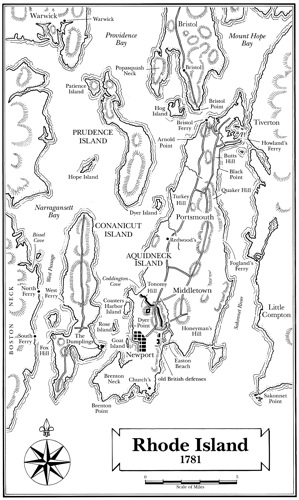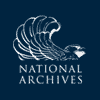George Washington to Lieutenant Colonel Alexander Hamilton, 7 March 1781
To Lieutenant Colonel Alexander Hamilton
½ past A.M. [Newport, 7 March 1781]
Dr Hamilton,
I shall be obliged to you for the answer to the address as soon as it is convenient to you. if we do not ride to the point1 to See the fleet pass out,2 I am to have a conference with Count De Rochambeau ⟨&⟩ the Engineer3 directly after Breakfast at which I wish you to be present. I am sincerely and Affectly Yrs
Go: Washington
ALS, DLC: Hamilton Papers. The docket has “March 80” struck out and “September 1780” written legibly. For the dateline given this letter, see Newport Citizens to GW, 7 March, source note.
Communications from Lieutenant General Rochambeau and Captain Destouches regarding the imminent sailing of the French fleet to the Chesapeake Bay had prompted GW to visit the French commanders at Newport (see Destouches to GW, and Rochambeau to GW, both 25 Feb.; see also GW to Destouches, and to Rochambeau, both 2 March). GW chose Maj. Gen. William Heath to command in his absence (see his second letter to Samuel Huntington, 1 March; see also GW to Heath, same date). GW, who traveled with his aides-de-camp Tench Tilghman and Hamilton, left headquarters at New Windsor in the morning on 2 March. GW’s enslaved servant William “Billy” Lee presumably accompanied the travelers (see GW to Hugh Hughes, 11 Feb.).
Rochambeau’s aide-de-camp Ludwig von Closen, who had brought letters from the French commanders, accompanied GW and tracked the party’s progress in his journal entries for 2–5 March. They dined with Col. Moses Hazen at Fishkill, N.Y., on 2 March and then went “25 miles farther on” to sleep at Andrew Morhouse’s home. “On the 3rd, one of General Washington’s saddle horses, while crossing over a wooden bridge, was frightened by its springy action, stepped aside, and broke his leg in trying to extricate himself from between the planks, so that we had to leave him

Map 1. GW traveled from New Windsor, N.Y., to Newport in March for consultations with Rochambeau and other French officers. (Illustrated by Rick Britton. Copyright Rick Britton 2022)
Closen next proceeded to Norwich, Conn., where GW planned “to dine” on 5 March. Riding to Newport on that date, Closen “ordered the night’s lodging for General Washington at Little Rest, where we had 8 hussars stationed for communications. I cautioned the cavalry corporal that they would have to guard him carefully during the night, as there were many Tories in the neighborhood” (, 63). Little Rest, now Kingston, is in South Kingstown, Rhode Island. The Connecticut Courant and Weekly Intelligencer (Hartford) for Tuesday, 6 March, reported that “Sunday last his Excellency General Washington, with his suite, passed through this town, on his way to the Eastward.” The Norwich Packet; and the Weekly Advertiser (Connecticut) for 8 March reported that on 5 March “his Excellency General Washington, and Major-General Howe, with their suit[e]s, passed through this town on their way to Newport, being saluted by a discharge of thirteen cannon” (see also Robert Howe to GW, 16 Feb.). A resident of South Kingstown wrote in his diary entry for 6 March that GW and a guard of twenty soldiers passed his home around 10:00 A.M. (see , 10).
Closen wrote in his journal entry for 6 March: “The arrival of General Washington, which I announced would occur the next day, created a general sensation throughout the army and among all the residents of Newport and the surrounding area. On the morning of the 6th, M. Destouches went in great state to meet him at the ferry, and conducted him on board the Duc de Bourgogne, where all the ships’ captains and general army officers were awaiting him. All the fleet was decked with flags and saluted him with 13 cannon shots. After a council of war that lasted two hours, General Washington was taken ashore to the great wharf, from which the troops lined the road to M. de Rochambeau’s house. The ground batteries saluted him with a dozen cannon shots, and the troops rendered him the honors of a marshal of France. … Everyone seemed pleased to see this famous Washington, and all the residents showed the same eagerness. The mayor proffered him a very eloquent address, to which he replied very warmly” (, 63; see also Newport Citizens to GW, 7 March). For a detailed account of the stops and expenses of GW and his traveling party between New Windsor and Newport, see 1–6. Tilghman kept the financial record (see Revolutionary War Accounts, Vouchers, and Receipted Accounts 2, 1775–1783, DLC:GW, ser. 5; see also 19).
Rochambeau’s chief commissary, Claude Blanchard, wrote in his journal that GW had “arrived about two o’clock. … I was presented to him. His face is handsome, noble and mild. He is tall (at the least, five feet, eight inches). In the evening, I was at supper with him. I mark, as a fortunate day, that in which I have been able to behold a man so truly great” (, 93; the source indicates that GW’s height is given in “French feet and inches”). French captain Berthier summarized events related to GW’s arrival in his journal entry for 6 March and also commented on GW: “The nobility of his bearing and his countenance, which bore the stamp of all his virtues, inspired everyone with the devotion and respect due his character, increasing, if possible, the high opinion we already held of his exceptional merit” (, 1:241–42). French lieutenant Brisout de Barneville noted in his journal entry for the same date that GW appeared handsome, masculine, affable, and serious. GW’s pensiveness suggested sound judgment without a brilliant spirit (see 255–56). For a civilian’s recollection of GW’s arrival in Newport, see , 362–63. GW participated in a torchlight procession that evening and reportedly responded to a boy who had “exclaimed loudly, ‘Why, father, General Washington is a man!’” by saying “‘Yes, my lad, and nothing but a man’” (, 364).
Berthier wrote in his journal entry for 7 March that GW observed the French fleet from “[Brenton’s] Neck, where he had gone to inspect the fortified camp of the army” (, 1:242; see also n.2 below). French naval officer Villebresme possibly saw GW on 7 March and later wrote in his memoirs: “I had the good fortune to see this famous man whose bearing, movements, and features were in accord with the opinion which I had already formed. Nature has given him a physical constitution which suits perfectly his other great capacities” (Henry J. Yeager, “The French Fleet at Newport, 1780–1781,” Rhode Island History 30 [1971]: 87–93, quote on 93). GW attended a ball in the evening and opened the entertainment by dancing a minuet with Margaret Champlin, whose father, Christopher, was a prominent local citizen (see , 265–67, 366, and 36).
Closen wrote in his journal entry for 8 March: “General Washington’s visit to Newport was the occasion for several celebrations; illuminations, dinners, suppers, and balls were given in succession” (Closen Journal, 64). French lieutenant Clermont-Crèvecœur recorded in his journal impressions of GW gathered during his visit: “General Washington is about 5 foot 10 or 11, well built, with a good figure. His face is handsome and his expression modest. Although cold, it conveys an impression of kindliness and affability. His uniform is simple and unadorned. He responded to the courtesies shown him in an altogether admirable manner. Our generals gave fêtes and balls in his honor at which he danced indiscriminately with everyone. …
“The town was superbly illuminated for his arrival. He spent eight days in Newport, during which the plans of the coming campaign were devised and soon put into execution” (, 1:25). No record of GW’s strategy conferences has been found, but Brigadier General Lauzun suggested that GW displayed “annoyance” that Rochambeau’s command decision for the French detachment to Virginia “would take the command of the expedition from M. de La Fayette, to whom he had intended to give it.” GW made “Rochambeau see that his requests were to be regarded as orders, but he did not choose to alter anything that had been done” (, 197; see also GW’s second letter to Lafayette, 20 Feb., source note, and , 99). For a sense of the probable discussions, see Rochambeau to GW, 31 March, and GW to Rochambeau, 7 April.
1. GW presumably refers to Brenton’s Point at the entrance to Newport Harbor. He apparently visited that place on this date (see the source note above).
2. The French fleet sailed from Newport on 8 March (see Destouches to GW, that date, source note).
3. GW probably means Jean-Nicolas Desandrouins (1729–1792), an accomplished military engineer who then held the rank of colonel and commanded the corps of engineers with the French expeditionary force.
For the names of French engineers then in Newport, see 425, 427.

![University of Virginia Press [link will open in a new window] University of Virginia Press](/lib/media/rotunda-white-on-blue.png)
